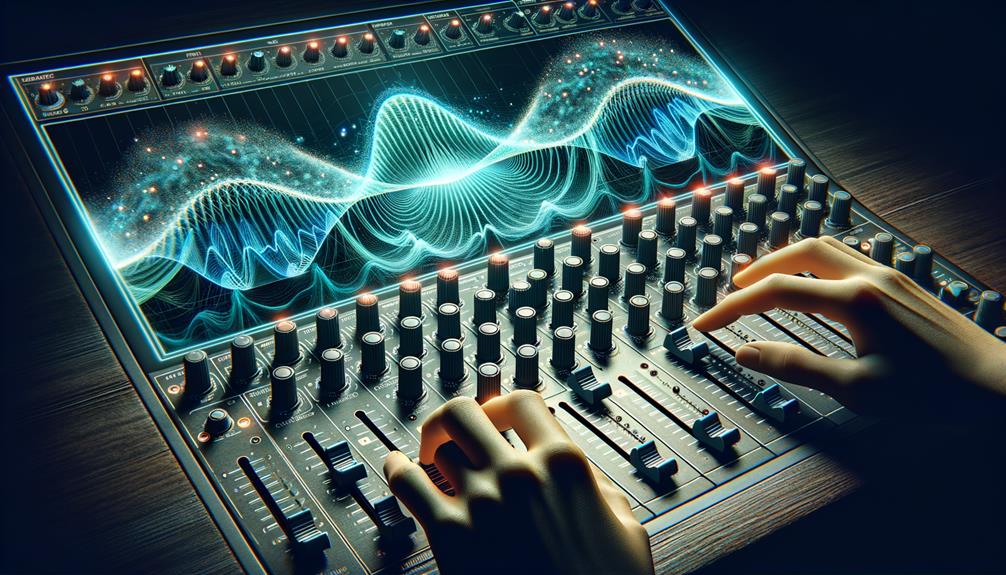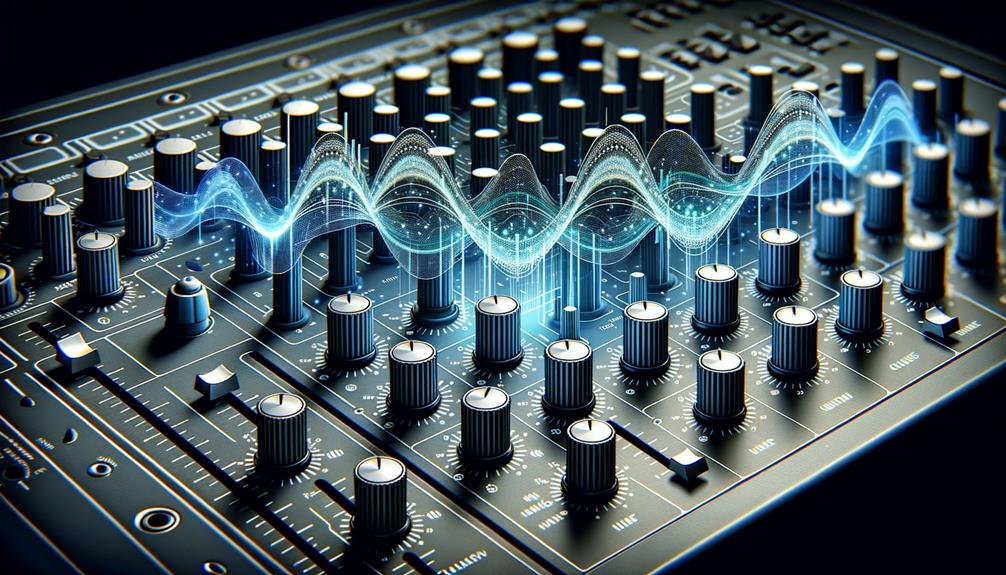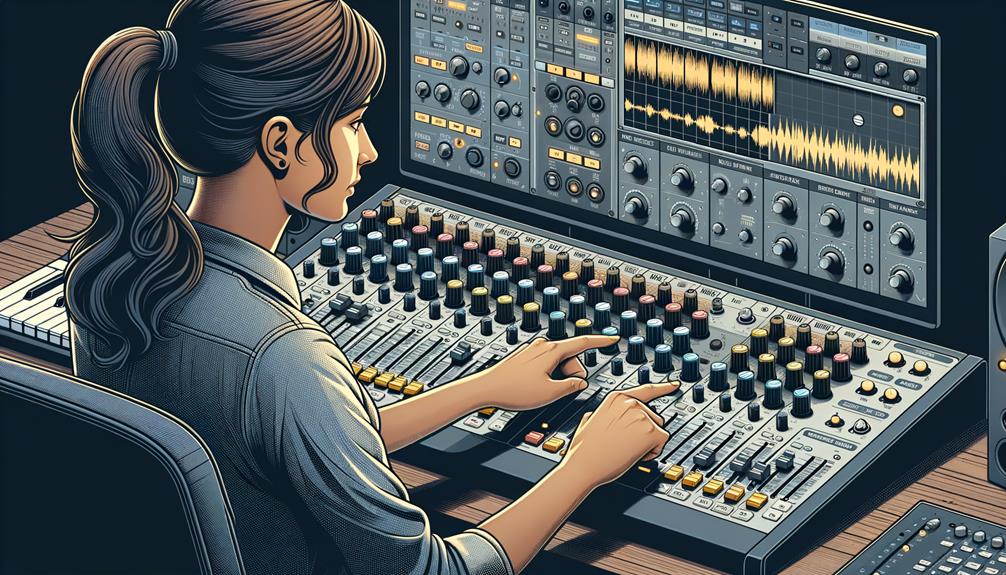No products in the cart.
You’ve probably heard of audio equalization being compared to a painter’s palette, where each frequency range is a different color waiting to be blended into the perfect mix.
But have you ever wondered about the precision and control that a parametric EQ can offer in this artistic process? Understanding what parametric EQ is and how it differs from other types of equalizers can be a game-changer in your journey to sculpting the ideal sound.
So, how does this tool work, and why is it so essential in the realm of audio engineering and music production?
Contents
hide
Key Takeaways
- Parametric EQ allows for precise adjustment of specific frequency ranges using four variables: frequency, filter type, Q factor, and gain.
- The frequency parameter is the center point of EQ adjustment, allowing for targeting specific frequencies.
- Different filter types offer versatile control over different frequency ranges.
- The Q factor determines the width or narrowness of the frequency band, allowing for fine control over the affected frequencies.
Understanding Parametric EQ Basics
Understanding the basics of parametric EQ involves precisely adjusting specific frequency ranges using four variables: frequency, filter type, Q factor, and gain.
The frequency parameter is the center point of the EQ adjustment, allowing you to focus on specific frequencies within the audio spectrum. This built-in parametric EQ tool used in audio editing provides a graphic interface for pinpoint adjustments.
Filter types such as high-pass, low-pass, peak, notch, high-shelf, and low-shelf offer versatile control over different frequency ranges, enabling you to fine-tune the audio output.
The Q factor determines the width or narrowness of the frequency band, influencing the sharpness and precision of the EQ adjustments. It’s a crucial parameter for achieving the desired audio balance.
Gain controls the increase or decrease in decibels, allowing for boosting or cutting specific frequencies. This allows you to adjust the specific frequency ranges to achieve the desired audio output.
Exploring Parametric EQ Applications
Exploring Parametric EQ Applications involves leveraging the precise control over specific frequencies provided by adjustable parameters such as frequency, filter type, Q factor, and gain to optimize sound in professional recordings, balance instrument and vocal volumes, and remove unwanted frequencies.
When you use a parametric EQ, you have the ability to adjust the center frequency, which allows you to target specific frequencies that need modification. This is especially useful when dealing with problematic frequencies in live sound situations, where feedback-causing frequencies can be precisely attenuated.
Additionally, parametric EQ allows you to adjust the gain within a specific frequency band, giving you fine control over boosting or cutting specific ranges. The ability to change the width of the affected frequencies, known as the Q factor, is another powerful tool. Narrow Q values can be used for precise correction of problematic frequencies, while wider Q settings are beneficial for gentle tone shaping.
When compared to graphic EQ, parametric EQ offers unparalleled control over equalization, making it an essential tool for a wide range of audio applications.
Practical Tips for Using Parametric EQ

When using a parametric EQ, it is crucial to understand how the four key variables – frequency, filter type, Q factor, and gain – provide precise control over specific frequency ranges. To optimize the use of parametric EQ, consider the following practical tips:
| Practical Tips for Using Parametric EQ | |
|---|---|
| Tip 1 | When targeting specific frequencies, narrow the bandwidth by increasing the Q factor. This allows for precise adjustments without affecting neighboring frequencies. |
| Tip 2 | Use the gain control to boost or cut specific frequencies. By carefully adjusting the gain, you can effectively shape the frequency spectrum to achieve the desired sound. |
| Tip 3 | Adjust every parameter thoughtfully. Utilize the filter type, frequency, Q factor, and gain controls to sculpt the frequency spectrum and achieve the desired audio result. |
Fine-Tuning With Parametric EQ
To achieve precise and nuanced adjustments to specific frequency ranges, the parametric EQ offers unparalleled control and flexibility through its four key variables: frequency, filter type, Q factor, and gain.
When fine-tuning with parametric EQ, the Q factor plays a critical role in shaping the frequency balance. Increasing the Q factor narrows the range of frequencies affected, allowing for pinpoint adjustments at the center of the frequency. Conversely, decreasing the Q factor widens the affected range, enabling broader adjustments across the spectrum.
This level of control empowers you to sculpt the sound with exceptional precision. By manipulating the Q factor, you can tailor the parametric EQ to suit your specific needs, whether it’s for surgically addressing problematic frequencies or gently shaping the tonal balance.
This capability makes the parametric EQ an indispensable tool for achieving the desired sonic characteristics in professional music production and sound engineering. The ability to finely adjust the Q factor sets the parametric EQ apart as a powerful instrument for shaping and perfecting audio output.
Harnessing the Power of Parametric EQ


Harness the Power of Parametric EQ by mastering its four adjustable parameters and gaining precise control over specific frequency ranges. Utilize parametric EQ to sculpt your audio with unparalleled precision and flexibility. Here’s how to harness its power:
- Use parametric EQ to target specific frequencies: With control over frequency, filter type, Q factor, and gain, you can precisely target and manipulate certain frequencies, allowing for detailed tone shaping and corrective sculpting.
- Lower the Q for a wider range: Decreasing the Q factor widens the frequency range affected by the EQ, enabling gentle, broad adjustments to the audio spectrum.
- Increase or decrease bandwidth for a narrow range: By adjusting the Q factor, you can narrow the frequency range affected by the EQ, allowing for pinpoint adjustments and surgical precision.
- Enjoy the versatility parametric EQ offers: Unlike graphic EQs, parametric EQ allows the user to shape the sound with a wider range of shapes and curves, providing more flexibility and control over the audio output.
Mastering the power of parametric EQ enables you to precisely tailor the audio to your exact specifications, making it an indispensable tool for engineers and producers seeking innovation and excellence in sound design.
Frequently Asked Questions
What Is the Difference Between EQ and Parametric EQ?
In audio processing, the difference between EQ and parametric EQ lies in the level of control over frequency bands. Parametric EQ allows precise adjustment of specific frequencies, offering more detailed sound manipulation for audio engineering and mixing techniques.
What Is an Example of a Parametric Eq?
An example of a parametric EQ is the Waves Q10, offering wide control over frequency, gain, and bandwidth. Its versatility suits various audio applications, offering precise customization of frequency bands and filter types for detailed sound shaping and audio control.
What Is the Purpose of a Parametric Equalizer?
Parametric EQ is crucial for audio manipulation, sound shaping, and tone adjustment. It provides precise frequency control, making it essential for signal processing and audio engineering. This studio equipment is vital for audio enhancement and frequency response, allowing for unparalleled sound sculpting.
What Is the Difference Between Fixed and Parametric Eq?
In graphic EQ vs parametric EQ, the latter offers precise control over frequency bands, filter types, Q factor, and gain. Ideal for music production, live sound, vocals, guitar, room acoustics, film sound, and podcasting, parametric EQ provides versatile and intuitive frequency shaping.
Conclusion
Now that you understand the basics of parametric EQ and its applications, you can use it to shape and balance audio frequencies with precision.
By adjusting the frequency, filter type, Q factor, and gain parameters, you can fine-tune the audio to achieve the desired sound.
With practice and experimentation, you can harness the power of parametric EQ to enhance the quality of your recordings and mixes.




